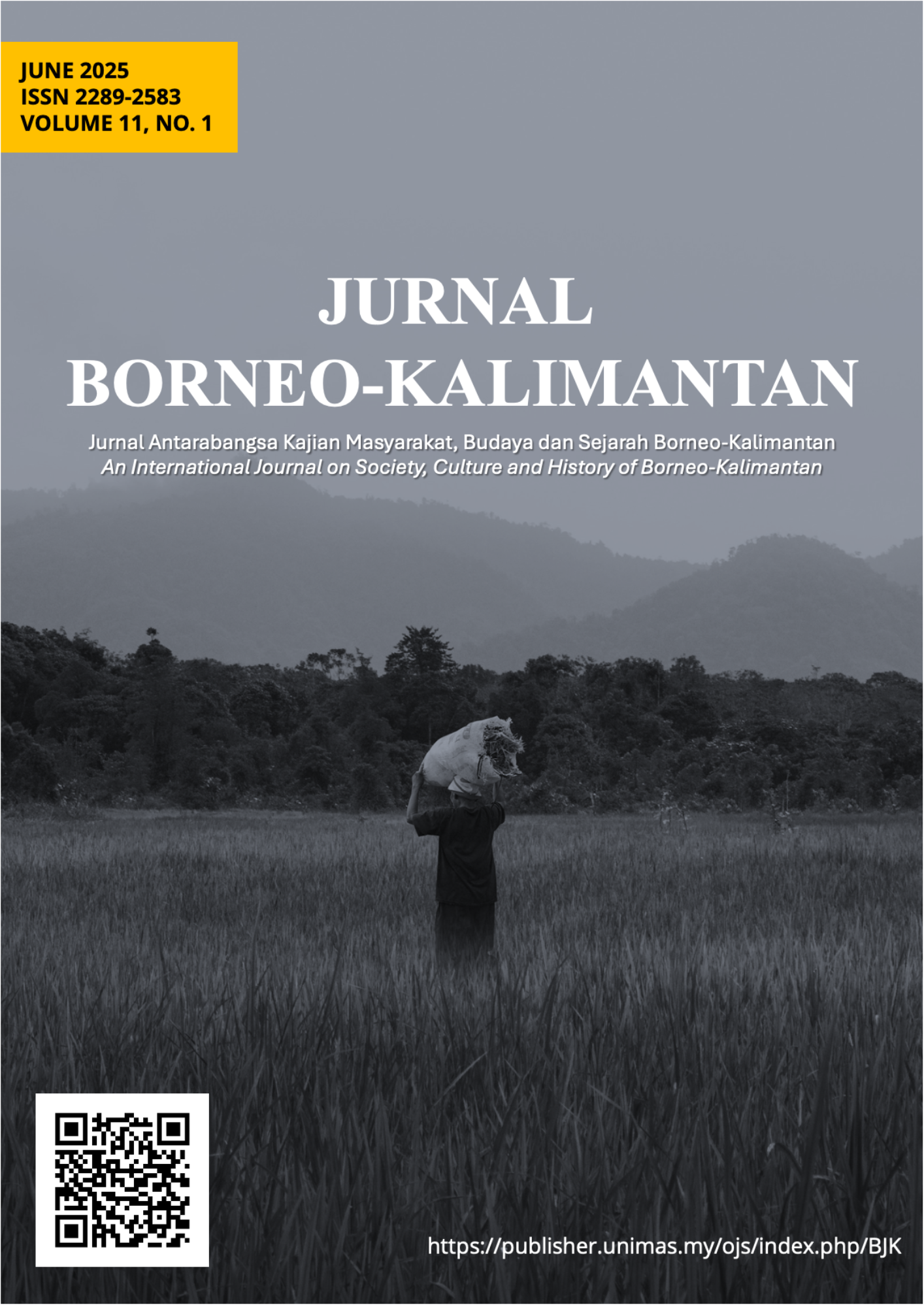Tradisi dan Penggunaan Mantera dalam Etnik Kenyah
DOI:
https://doi.org/10.33736/jbk.9591.2025Keywords:
Mantera, tradisi lisan, Kenyah, tranformasi budaya, budaya perubatanAbstract
Mantera merupakan elemen sosio-budaya masyarakat. Dalam konteks masyarakat Kenyah tradisional, mantera dipelajari dan dipindahkan kepada ahli-ahli masyarakat melalui penggunaan bahasa lisan dan ritual berkenaan mantera diamalkan dalam kehidupan harian seperti budaya bertanam padi dan budaya penyembuhan. Melalui mantera, corak pemikiran dan budaya masyarakat Kenyah diteliti sebagai usaha merungkai tradisi mantera tradisional dan perubahan yang berlaku akibat agen transformasi sosial seperti pengenalan agama Kristian, pendidikan formal dan perkhidmatan bioperubatan, budaya berasaskan wang dan penggunaan teknologi. Kajian menunjukkan amalan budaya mantera didapati dalam pelbagai aspek sosio-budaya seperti adat resam dan pantang larang, perubatan, pertanian, dan kepahlawanan. Walau bagaimanapun budaya mantera hampir pupus kerana budaya berkenaan hanya diamalkan oleh golongan tua.
References
Chen, P.C.Y. (1975). Medical systems in Malaysia: Cultural bases and differential use. Social Science & Medicine, 9(3), 171-180.
Chen, P.C.Y. (1981). Traditional and modern medicine in Malaysia. Social Science & Medicine, 15A, 127-136.
Conley, W.W. (1974). Kenyah cultural themes and their interrelationships. Sarawak Museum Journal. 22, 311-324.
Galvin, A.D. (1968). Mamats chants and ceremonies, Long Moh (upper Baram). Sarawak Museum Journal 16: 235-248.
Gollin, L. (2001). The taste and smell of taban Kenyah (Kenyah medicine): An exploration of chemosensory selection criteria for medicinal plants among the Kenyah Leppo’ Ke of East Kalimantan, Borneo Indonesia. PhD Thesis. University of Hawai’i.
Hashim Awang, A.R. (1990). Antropologi perubatan. Kuala Lumpur: Dewan Bahasa dan Pustaka.
Harun, D. (2001). Mantera Melayu: Analisis pemikiran. Penang: Penerbit Universiti Sains Malaysia.
Haviland, W.A, Prins, H.E.L, Walrath, D & McBride, B. (2005). Cultural anthropology: The human challenge. Toronto, Can: Thomson Wadsworth.
Hong, E. (1978). The process of sociocultural change in a Kenyah community. AKADEMIKA 13: 31-44.
Majlis Adat Istiadat Sarawak. (1994) Adet Kayan-Kenyah. Kuching: Percetakan Nasional Berhad.
McDougall, W; Hose, C & Haddon, A.C. (1912). The pagan tribes of Borneo: a description of their physical, moral intellectual condition, with some discussion of their ethnic relations. Volume 2. London, UK: MacMillan And Co., Limited.
Miller, B. (2009). Cultural Anthropology (Fifth ed.). Upper Saddle River, NJ: Prentice Hall.
Liau, J. (1997). Sistem kekeluargaan dan penamaan masyarakat Kenyah di Long Bulan, Belaga, Sarawak (Tidak diterbitkan). Tesis Sarjanamuda Sastera. Bangi: Universiti Kebangsaan Malaysia.
Liau, J. (2007). Anthropological study of Ketene’: The Kenyah verbal art. Working Paper Series No. 15. Faculty of Social Sciences, Kota Samarahan: Universiti Malaysia Sarawak.
Liau, J. (2013). “It’s not the end of the world”: Living with disability following road traffic accidents in Sarawak, Malaysia. Unpublished PhD Thesis. Clayton, VIC: Monash University.
Downloads
Published
How to Cite
Issue
Section
License
Copyright (c) 2025 Jurnal Borneo-Kalimantan

This work is licensed under a Creative Commons Attribution-NonCommercial-ShareAlike 4.0 International License.
-
Copyright Transfer Statement for Journal
1) In signing this statement, the author(s) grant UNIMAS Publisher an exclusive license to publish their original research papers. The author(s) also grant UNIMAS Publisher permission to reproduce, recreate, translate, extract or summarize, and to distribute and display in any forms, formats, and media. The author(s) can reuse their papers in their future printed work without first requiring permission from UNIMAS Publisher, provided that the author(s) acknowledge and reference publication in the Journal.
2) For open access articles, the author(s) agree that their articles published under UNIMAS Publisher are distributed under the terms of the CC-BY-NC-SA (Creative Commons Attribution-Non Commercial-Share Alike 4.0 International License) which permits unrestricted use, distribution, and reproduction in any medium, for non-commercial purposes, provided the original work of the author(s) is properly cited.
3) For subscription articles, the author(s) agree that UNIMAS Publisher holds copyright, or an exclusive license to publish. Readers or users may view, download, print, and copy the content, for academic purposes, subject to the following conditions of use: (a) any reuse of materials is subject to permission from UNIMAS Publisher; (b) archived materials may only be used for academic research; (c) archived materials may not be used for commercial purposes, which include but not limited to monetary compensation by means of sale, resale, license, transfer of copyright, loan, etc.; and (d) archived materials may not be re-published in any part, either in print or online.
4) The author(s) is/are responsible to ensure his or her or their submitted work is original and does not infringe any existing copyright, trademark, patent, statutory right, or propriety right of others. Corresponding author(s) has (have) obtained permission from all co-authors prior to submission to the journal. Upon submission of the manuscript, the author(s) agree that no similar work has been or will be submitted or published elsewhere in any language. If submitted manuscript includes materials from others, the authors have obtained the permission from the copyright owners.
5) In signing this statement, the author(s) declare(s) that the researches in which they have conducted are in compliance with the current laws of the respective country and UNIMAS Journal Publication Ethics Policy. Any experimentation or research involving human or the use of animal samples must obtain approval from Human or Animal Ethics Committee in their respective institutions. The author(s) agree and understand that UNIMAS Publisher is not responsible for any compensational claims or failure caused by the author(s) in fulfilling the above-mentioned requirements. The author(s) must accept the responsibility for releasing their materials upon request by Chief Editor or UNIMAS Publisher.
6) The author(s) should have participated sufficiently in the work and ensured the appropriateness of the content of the article. The author(s) should also agree that he or she has no commercial attachments (e.g. patent or license arrangement, equity interest, consultancies, etc.) that might pose any conflict of interest with the submitted manuscript. The author(s) also agree to make any relevant materials and data available upon request by the editor or UNIMAS Publisher.

